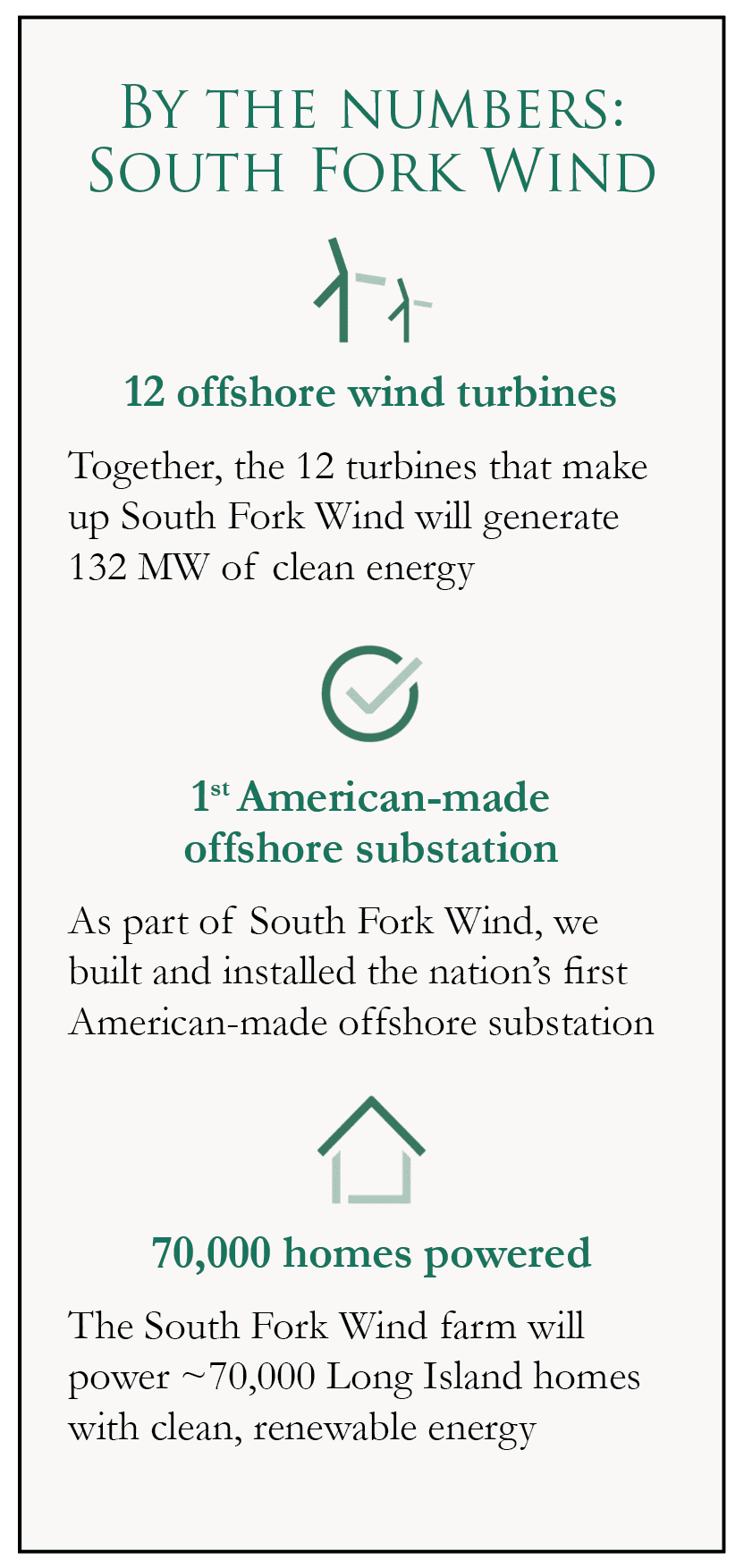The South Fork Wind Project marks a significant milestone in New York State’s journey toward renewable energy. The project was the first utility-scale offshore wind farm to begin operation in the United States when the first two of 12 turbines began generating power on December 6, 2023.
The 12-turbine project is located approximately 35 miles east of Montauk Point on Long Island and was fully functional in mid-March 2024. The South Fork Wind project will generate 130 megawatts (MW), which is enough to power about 70,000 homes annually. Its successful completion is the first step toward the state’s Climate Leadership and Community Protection Act requirements. The Act is designed for the state to achieve 70 percent renewable energy by 2030, which includes the installation of nine gigawatts of offshore wind by 2035.
“Clean, renewable power flowing from the South Fork Wind project is an important part of our overall mission to create a clean-energy economy in New York State,” said Public Service Commission Chair Rory M. Christian in a March 2024 press release.
South Fork Wind was the first commercial-scale offshore wind project completed as part of the Biden administration’s offshore wind energy initiative. Eight commercial-scale offshore wind power projects totaling over 10 GW have been approved through the initiative, the first steps in reaching the goal of 30 GW by 2030.
In April 2024, Secretary of the Interior Deb Haaland announced in a press release “a new five-year offshore wind leasing schedule, including up to 12 potential offshore wind energy lease sales through 2028.”
The South Fork Wind project, a partnership by Ørsted and Eversource, relied on Long Island companies to install the underground duct bank, onshore substation, and onshore cables, manufacture the concrete buttresses, and fabricate steel for portions of the project foundations, according to Ørsted’s website. Manufacturing and assembly of multiple other project components also occurred domestically in Texas, South Carolina, Rhode Island and Connecticut.
“From the first steel in the water to the final turbine, our hard-working offshore wind construction team has put South Fork Wind on the path to making American energy history. We’re incredibly proud of our dedicated project, permit and construction teams, and all those who have made this milestone possible,” wrote Ørsted Group EVP and CEO Americas David Hardy in a statement.
 Additional Commercial Scale Offshore Wind on the Horizon
Additional Commercial Scale Offshore Wind on the Horizon
Flipping the switch on the South Wind Fork project coincided with an announcement by New York Governor Kathy Hochul that two more offshore wind projects have been awarded and are known as Empire Wind I and Sunrise Wind.
According to the Governor’s office, the sites will collectively generate more than 1,730 Megawatts of energy and $2 billion in near-term economic development investments. Equinor is developing Empire Wind 1, an 810-megawatt project located 15 miles off the Long Island shore across 80,000 acres in ocean waters ranging from 75 to 135 feet deep.
Construction started with a groundbreaking on June 10, 2024, for the South Brooklyn Marine Terminal, which will serve as the hub for offshore wind projects along the East Coast. The project has received approval to connect to New York’s electric grid, and completion is expected by 2026.
Sunrise Wind, a 924-megawatt project developed in partnership by the Ørsted Group and Eversource, which has since sold its stake to the Ørsted Group, is estimated to power nearly 600,000 homes in New York once completed.
The two projects are expected to reduce greenhouse gas emissions by more than three million metric tons each year, equal to taking 740,000 cars off the road each year. According to the Governor’s office, the energy produced will power more than one million New York homes.
However, not all commercial-scale offshore wind projects in the state have been smooth sailing. Three projects totaling 4 GW of capacity were canceled on April 9, 2024. The New York State Energy Research and Development Authority (NYSERDA) had provisionally awarded GE Verona and LM Wind Power $300 million of grant funding for local nacelle and blade manufacturing.
In a press release, NYSERDA cited “material modifications” and “technical and commercial complexities” between the provisional awardees and their partners. In the initial bid proposal, GE Verona proposed 18 MW Halide-X turbine platforms, which it later changed to a 15.5/16.5 MW platform. The materials change led to the cancellation of the projects, which included the 1,404-MW Attentive Energy One, the 1,314-MW Community Offshore Wind, and the 1,314-MW Excelsior Wind.
New England Leads Wind Energy Push
In 2023, multiple states in New England established or expanded goals for offshore wind projects. For example, Maryland Governor Wes Moore boosted his state’s offshore wind goals from 2 GW to 8.5 GW to achieve 100 percent clean energy by 2035.
Maine lawmakers approved a bill to procure 3 GW of offshore wind by 2040. Connecticut’s Offshore Wind Strategic Roadmap details how the state will reach its goal of 100 percent zero-carbon electricity by 2040. A first-ever multi-state offshore wind procurement agreement was signed by three states: Massachusetts, Rhode Island and Connecticut.
Robert J. Rodriguez, New York’s Secretary of State, is quoted in a press release as saying, “Offshore wind is not just a source of renewable clean energy but also fosters economic growth, energy independence and environmental protection.”
Headline photo: NY Gov. Kathy Hochul at the Sunrise Wind groundbreaking on July 16, 2024. Photo courtesy of Ørsted.
Katie Navarra is a non-fiction writer. Her byline has appeared in Popular Science, The Motley Fool, Education Dive, ChemMatters, Society of Human Resources Management, Western Horseman Magazine and Working Ranch, among others.





